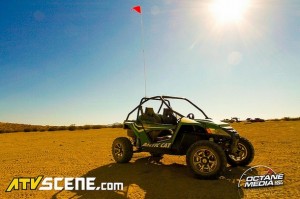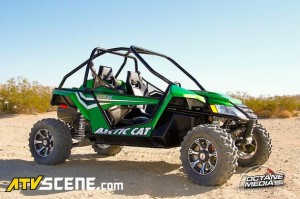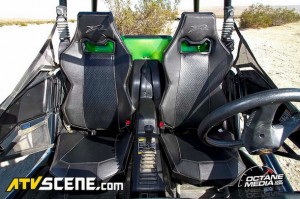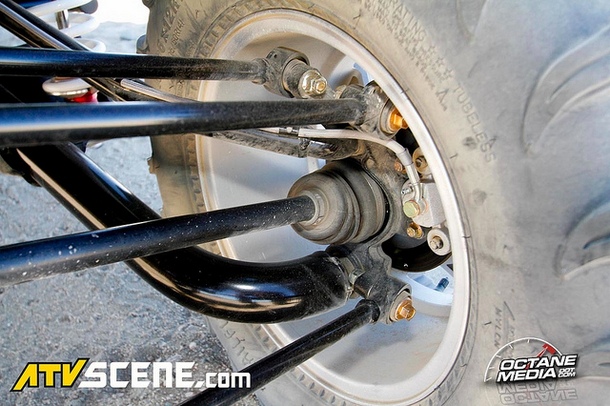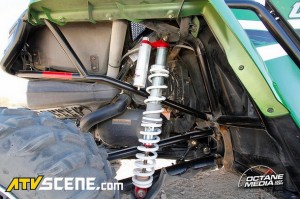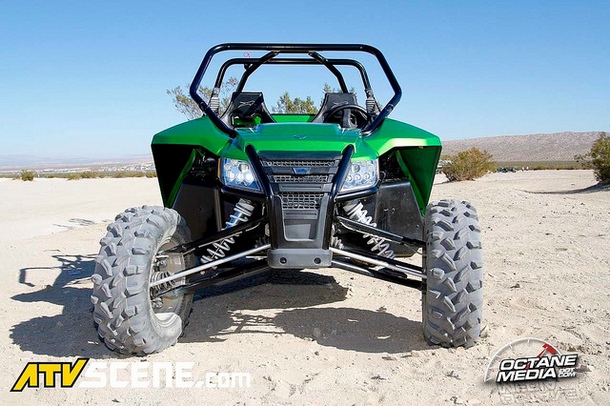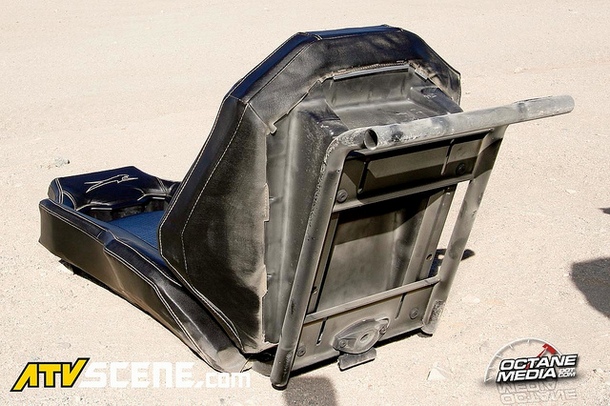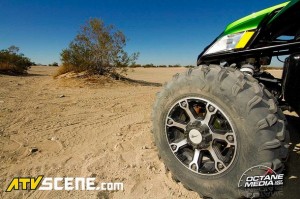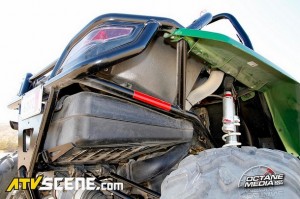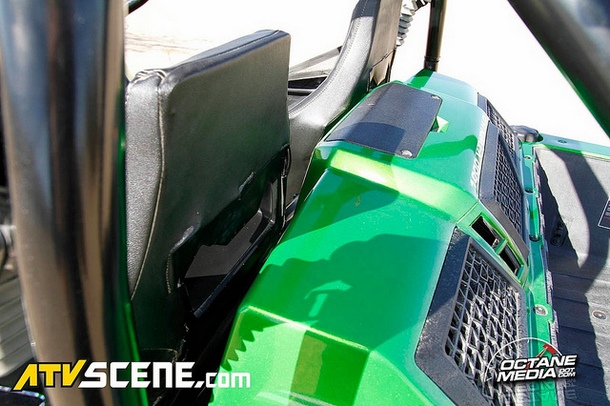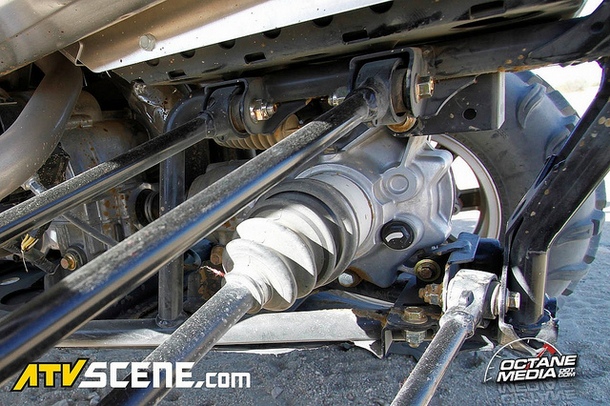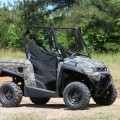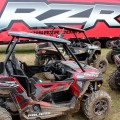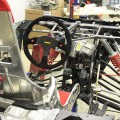2012 Arctic Cat Wildcat 1000i H.O Ride Review
- Updated: November 10, 2011
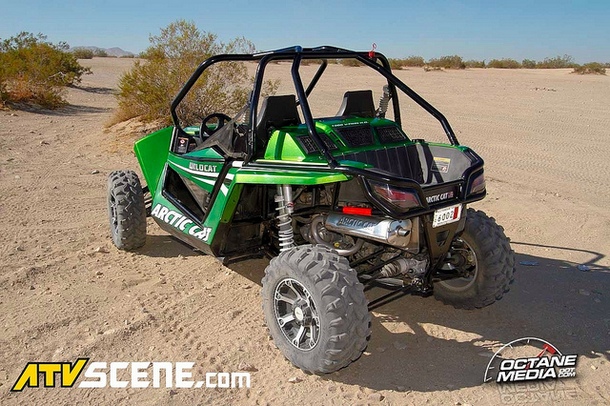
Not since the rumors first surfaced of the Polaris RZR-XP have I been so consumed with the possibilities of a new side by side entering the market. Now that the XP has been around for a year, it has a solid reputation for high performance and high durability. Will Arctic Cat’s newcomer to the scene be able to dethrone the king? Read on and we’ll see.
To properly set the stage, I race a Polaris RZR-XP about two to three weekends a month, so I am quite familiar with the handling, power and aesthetics of the XP. If you’re reading this article, you are probably interested in purchasing a new big-bore UTV or you just purchased a XP and you’re wondering if you bought the wrong machine. Hopefully I will answer all of these questions and more by the time we’re done.
Preconceived Notions
These are my thoughts before ever laying eyes on a Wildcat. They’re simply observations I took from viewing the photos and renderings scattered throughout the Internet. I think this is important to this article because you may have some of the same thoughts…
Low Stance – or more appropriately, the seating compartment sits near the bottom of the vehicle. In my experience, this should aid in lowering the center of gravity, so at this point in the review, I think that’s a good thing.
Long – coming in at 95” (13.4” longer than the RZR-XP), this is one big machine. That should make it very stable through the rough choppy terrain of the West Coast, but it may be an issue on the tight wooded terrain often consuming most of the East Coast recreation areas. It could also be an issue for “short course” UTV riding and racing. These tracks are primarily GP-style motocross tracks featuring short, low jumps. The RZR-XP’s “bucking” issue is overly visible on these types of tracks. I am very interested to see how this vehicle compares on similar small jumps. Maybe the extra length will be the cure.
Power Steering – power steering is a huge asset for all UTV’s. I’m excited to see Arctic Cat stepping up and including power steering as an original equipment item.
Engine – with 951 cc’s, it comes in at 76 cc’s above the RZR-XP (875 cc’s). I’m curious to see how efficiently this engine gets this displacement advantage to the ground.
Shocks – the OEM shocks on the XP are Fox Podium 2.0’s. They are great for stock, but they still have room for improvement. The Wildcat features 2.0 Walker Evans shocks with dual rate springs, compression adjusters and crossovers. It looks to be a great shock package. The Wildcat also has a huge amount of front and rear travel. This should be especially useful on the West Coast. We will be testing in Barstow, so we will be able to put this travel to the test pretty quickly.
Radiators – one of the standout features for me was the location of the radiators – behind the passenger compartment. I have had several issues with the front-located radiator on the XP becoming covered in roost from the vehicle in front of me. The radiator location of the Wildcat should prevent this from being an issue.
First Viewing
After finally laying eyes on the Wildcat in person, a few things were apparent…
Beautiful paint – this thing is really a looker. The green machines (available in green or black) have a deep metallic flake mixed into the paint. It gives the machine a very unique look that I like very much.
Beefy chassis – the majority of the Wildcat’s chassis is 1.75” HSLA (High Strength, Low Alloy). I was impressed with the design and layout of the chassis.
Great looking seats – I have seen photos of the seats, but seeing them up close, I was surprised with how well they were built. The material in the sitting area is also a little “grippy”, which keeps you firmly planted in the seat.
Tie rod location – the steering box is located in front of the spindle pivot, and the tie rods connect to the front of the spindle, rather than the rear of the spindle common on other UTVs. There are some performance benefits to this approach, but I also see it as a liability due to the tie rod being the point of first impact if the vehicle hits a tree or other obstacle in the right location.
Long – the photos don’t do this thing justice. It’s a very long machine. No doubt this extra length will be very helpful through the rough desert terrain.
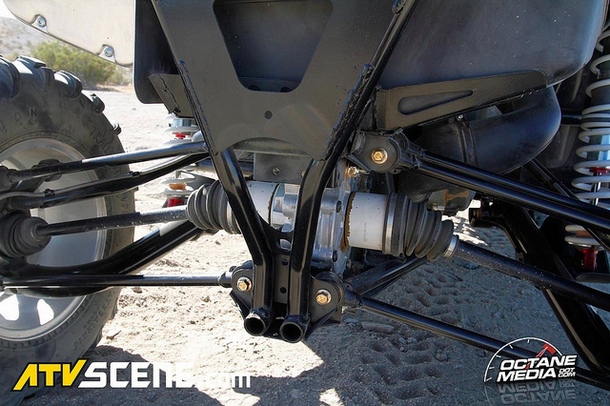
Notice how slim the rear differential is and how close the bottom frame rails are to each other. This greatly aids in articulation and vehicle stability.
Ride Review
Suspension – the most apparent trait of the Wildcat is the suspension. Words can’t explain how good this vehicle is through the whoops and large g-outs. It literally took me three or four laps around our mock race course to get it up to speed. I constantly had to adjust my expectations after each lap. It took me about 5 laps (est. 30 minutes) behind the wheel to feel like I was really pushing the machine. The terrain at Barstow is world renowned for being very tough on man and machine, so this was definitely a true test of the Wildcat’s suspension capability. I give the suspension a 9 out of 10. The only reason it didn’t get a 10 was due to the shock valving, but keep in mind that the machines we were on were pre-production units and the shock valving has to be fairly generic due to the wide amount of terrain on which these vehicles will be driven. A quick twist of the compression adjusters make a good shock even better. Walker Evans makes a great product and I don’t see many racers or riders needing to change the from the stock shocks. At the very most, some hard core racers might want to revalve them, but the average driver will find more than enough adjustability in the stock shocks to tailor the ride to their specific needs. The only thing I have against the suspension is actually a hit against the rear shock mounting design. I would like to see the bottom shock mount (on the lower trailing arm) mounted in a double shear style. Hopefully this won’t be an issue, but in its current location, it could be susceptible to impact with a trail obstacle, causing all sorts of problems. Mounting it in double shear would prevent this issue.
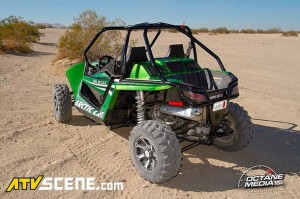 Engine – to be honest, I expected a little more from the engine. Don’t get me wrong, this vehicle will run 65+ down the dessert roads at ease, but I feel the suspension is head and shoulders above the engine. The engine and clutch combination deliver a VERY predictable engagement and make for smooth and affective acceleration. For the East Coast trail riders out there, this engine and clutch combination perform at slow speeds much better than that of the powertrain found on the RZR-XP. I attribute that to precise clutch setup and smooth power delivery of the Wildcat’s engine. It’s hard to give the engine a proper score because the only issues it had were meeting my expectations and keeping up with the amazing suspension. I give the powertrain (engine/clutch) a 7 out of 10.
Engine – to be honest, I expected a little more from the engine. Don’t get me wrong, this vehicle will run 65+ down the dessert roads at ease, but I feel the suspension is head and shoulders above the engine. The engine and clutch combination deliver a VERY predictable engagement and make for smooth and affective acceleration. For the East Coast trail riders out there, this engine and clutch combination perform at slow speeds much better than that of the powertrain found on the RZR-XP. I attribute that to precise clutch setup and smooth power delivery of the Wildcat’s engine. It’s hard to give the engine a proper score because the only issues it had were meeting my expectations and keeping up with the amazing suspension. I give the powertrain (engine/clutch) a 7 out of 10.
Rider Comfort – as I suspected, the seats in the Wildcat are great. The material used feels thick and durable. The form fitting design keeps you planted in the seat through even the roughest terrain. The racers out there will notice harness cutouts in the stock seats. To make this vehicle race legal, all you’ll need to do is modify the plastic radiator shroud (behind the seat back) to reveal a chassis bar to which you can connect your harnesses. I don’t see any reason for most racers out there to change the seats. They should be sufficient and comfortable for most, but do not provide access to a submarine belt. If your race series requires a 5-point harness, you will either need to modify the seat bottom or replace the seats. I give the seats a 10 out of 10 as they are the best stock seats I have seen.
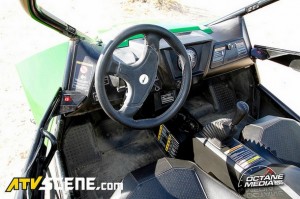
Leg room was not as plentiful as I was hoping for such a large machine, but it should be more than sufficient for most drivers.
Shifter – I was disappointed in the gear selector. The indents for the specific transmission drive locations were not as distinguishable as I would like, and for this reason I noticed that I bumped the gear selector into other locations a couple of times. My other complaint with the shifter is that the foremost (toward the front of the vehicle) selector position was low range. Just before low range was high range. That means to get the vehicle into high range, you would first need to move the shifter into low range (to reach the end of the movement) and pull back one position to high range. Personally, I would like to have seen high range at either end of the shift pattern. I don’t see much use for low range in most situations. I give the shifter a 4 out of 10.
Doors – the doors used on the Wildcat are great. The one button latching system worked very well and provided a secure feeling inside of the vehicle. I’m very happy to see Arctic Cat going above and beyond to build their machine to a higher safety standard. Unfortunately, the door handles on the inside of the door were right against my knee (similar on the passenger side). I left the ride with large bruises on my left knee from it bouncing off of the door and door handle, but keep in mind that I was driving this machine very hard for hours. I’m also a little taller than most, at 6’2”, so this may be a non-issue for the average rider. Overall, I give the doors an 8 out of 10.
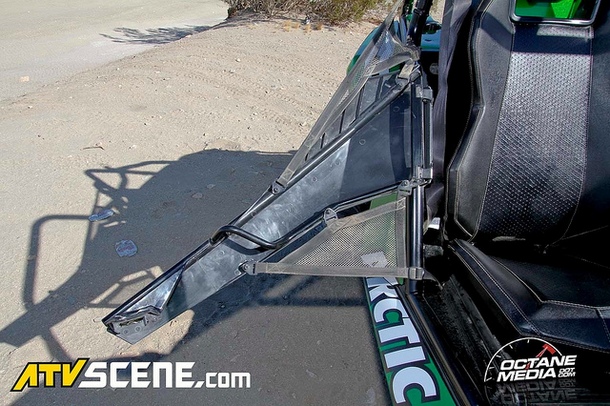
The inclusion of solid doors on the Wildcat is a great move toward a safer vehicle. I would like to see all sport SXS’s have solid doors like these.
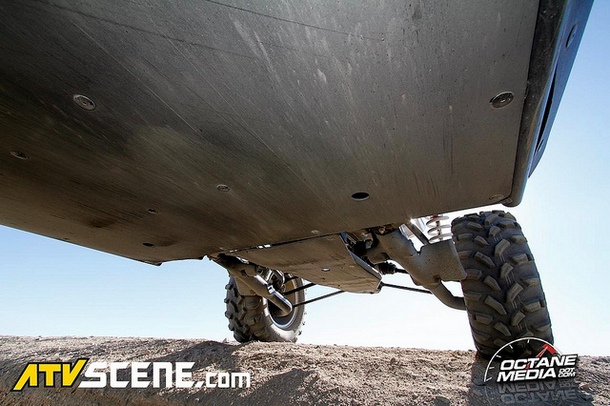
The one-piece chassis belly skid is absolutely necessary in any terrain. The perfectly smooth undercarriage will help the Wildcat slide over most obstacles.
Viewing Area – often times low seat positions compromise the driver’s ability to see the terrain in front of them. Due to the quick downward sloping angle of the front of the Wildcat, this was not an issue. Viewing area was perfect. I give the driver position a 10 out of 10.
Wheels – the OEM wheels on the Wildcat are cast aluminum and 14” tall. I run 14” wheels on my XP and love them, but I ride mostly East Coast terrain. I think a better all around wheel size would be 12”. I had a handful of situations where I felt I had punctured a tire due to a rock impacting the wheel. It also made for a fairly rough ride through the rock sections. On the flip side, running a 27” or 28” tire would probably be a good fix for this and provide some extra ground clearance if the terrain permitted. I really like the design and look of the wheels, though. It adds a lot to the flare to the vehicle. I give the wheel choice an 8 out of 10.
Steering – the power steering was absolutely perfect, at all speeds. However, the turning radius was too large for my liking. In the desert and most West Coast terrain that will not be an issue, but on the East Coast, three point turns will be common. Due to the power steering being so spot-on, I’m going to give more weight to that and give the steering an overall score of 9 out of 10.
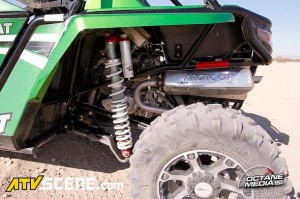
The OEM exhaust provides an intimidating throaty growl that can be heard for miles in the open desert.
Exhaust – normally the exhaust would not be part of a ride review, but the sound that this exhaust gives off is great. It sounds like a small V8 race car. It definitely adds to the experience of driving this incredible machine. The exhaust is also ceramic coated to prevent corrosion and promote proper heat dissipation.
PTL (Peak Torque Limiter) – When I read this bullet point in the Arctic Cat literature, honestly I just breezed over it. At first glance, it didn’t seem like that big of a deal. The PTL is basically a “slipper clutch” used to act as a fuse between the engine and transmission. It absorbs the sudden torque spike caused by staying on the gas in the air and then landing, which would normally transfer that torque spike into your driveline directly into your axles and CV joints. The slip is very brief, but a huge asset while driving at high speed. I have been through several rear axles on my XP, so I am used to lifting while in the air. This was not necessary on the Wildcat. It provided a great, confidence-inspiring ride. In my opinion, this is a huge asset to the durability and longevity of the Wildcat.
Durability – let’s be frank, in the history of the Arctic Cat line, some people have said some of their vehicles are unreliable. Personally, I don’t have any experience or data to back that up. It’s sort of like the Chevy vs. Ford debate. Some are very passionate about their particular brand and hold a biased opinion toward Arctic Cat. This vehicle appears to be built from the ground up as a very solid sport-performance vehicle. Most of the parts on this vehicle are purpose built for the Wildcat. It does share the engine and transmission from a few previous models (Prowler, Thundercat, etc.), but it has proven to be potent and reliable in those respected vehicles. The particular vehicle that I drove in Barstow had already been put through several hundred miles of Barstow terrain. I would relate this to a couple of thousand miles on the trail. I can understand where some of you out there who are unfamiliar with the Barstow area would see that as an exaggeration, but ask anyone who has been there and I think they would agree with my assessment. Over the brutal pounding that this vehicle saw, it performed flawlessly, and I drove it to its absolute ragged edge for quite a while. The steering was tight. The bushings were still perfect and I didn’t notice any lose or suspect parts. I was very impressed with its durability. From my experience on this highly tested vehicle, I give the durability a 10 out of 10.
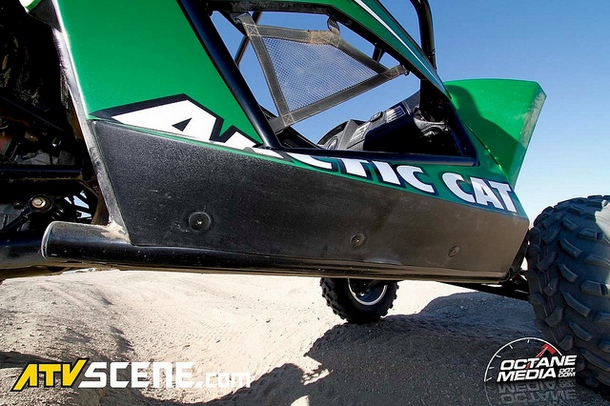
The plastic rocker guards are surely one of the first things that will need to be covered or replaced. They are not up to the task.
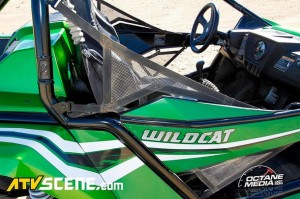 Verdict
Verdict
I know many of you scrolled down the page to get to this part of the article. This is what we’ve all been waiting for. The bottom line is that Arctic Cat has developed a truly game-changing vehicle. Right out of the box, the Wildcat delivers unparalleled suspension and handling that allows you to effortlessly hammer through rough, whooped-out terrain. Most race cars I’ve been in can’t hold a candle to the way the Wildcat performs through whoops and g-outs. If you are a West Coast rider/racer, you need to take a serious look at the Wildcat. It would take very little effort and money to turn this vehicle into a race-winning-machine.
However, and yes, there’s always a flip side, if you’re only going to ride/race on the East Coast, this might not be the vehicle for you. I say “might”, because this is only an educated guess. The extra length and large turning radius could cause problems in the tighter trails found in the deep woods of the East Coast. I’m also unsure of how well the suspension will perform over East Coast terrain, but one thing is for sure, you have shocks that are tunable enough to get them to your exact preference. I don’t think the suspension will be an issue for anyone, regardless of which side of the country you live on.
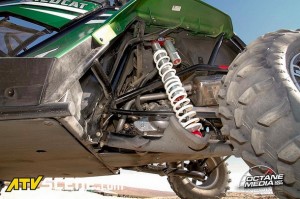
I was pretty disappointed in the rear shock guards and the single shear mounting of the rear shock. This is something to watch closely.
Suspension – best in the industry, period. Engine – needs some aftermarket love to bring it up to par with the RZR-XP. There’s no doubt that a little tender loving care will bring this beast to life. Once the engine is brought up to par with the suspension, this vehicle could be unstoppable.
I hope that answers all of your questions, if not, post your questions in the comments below and I’ll do my best to get them answered as quickly as possible.
Arctic Cat is taking the Wildcat on a national tour. You will get your chance to get some seat time in it yourself by checking out your closest ride location. If you’re interested in a high performance sport UTV, you definitely need to consider the Wildcat. .
